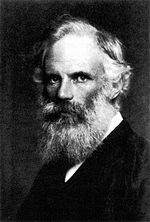George FitzGerald
| George Francis FitzGerald | |
|---|---|

George Francis FitzGerald
|
|
| Born | 3 August 1851 Dublin, Ireland |
| Died |
22 February 1901 (aged 49) Dublin, Ireland |
| Nationality | Irish |
| Fields | physics |
| Institutions | Trinity College, Dublin |
| Alma mater | Trinity College, Dublin |
| Notable awards | Royal Medal (1899) |
Prof George Francis FitzGerald FRS FRSE (3 August 1851 – 22 February 1901) was an Irish professor of "natural and experimental philosophy" (i.e., physics) at Trinity College in Dublin, Ireland, during the last quarter of the 19th century. He is known for his work in electromagnetic theory and for the Lorentz–FitzGerald contraction, which became an integral part of Einstein's Special Theory of Relativity. The FitzGerald crater on the far side of the Moon is named for him. The FitzGerald Building at Trinity College, Dublin is named after him.
FitzGerald was born at No. 19, Lower Mount Street in Dublin on 3 August 1851 to the Reverend William FitzGerald and his wife Anne Frances Stoney (sister of George Johnstone Stoney and Bindon Blood Stoney). Professor of Moral Philosophy in Trinity and vicar of St Anne's, Dawson Street, at the time of his son's birth, William FitzGerald was consecrated Bishop of Cork, Cloyne and Ross in 1857 and translated to Killaloe and Clonfert in 1862. George returned to Dublin and entered Trinity as a student at the age of 16. He became a Fellow of Trinity in 1877 and spent the rest of his career at this college, becoming Erasmus Smith's Professor of Natural and Experimental Philosophy in 1881.
...
Wikipedia
